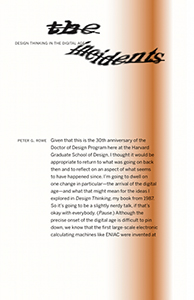In this essay, professor Peter G. Rowe gives an overall description of how
new technologies transformed the field of architectural design, addressing issues such as the precision and incompleteness of information, schema theory and heuristics.
In 1987, Peter G. Rowe published his pioneering book Design Thinking. In it, he interrogated conceptual approaches to design in terms of both process and form. Thirty years later, in a lecture at the Harvard University Graduate School of Design, Rowe offered a reappraisal of his earlier work, describing ways in which the capacities of the digital age have changed the way we perceive and understand creative problem-solving in architectural design. In this new account of “design thinking” based on that memorable talk, Rowe charges that ideas about the “precision” and “incompleteness” of information have become exaggerated and made more manifest. He dives into the crucial role of schema theory and the heuristics that flow from it, but concedes that the “ineffable characteristics of design problems and of design thinking also appear to have remained.”
This book is part of “The Incidents” series, based on events that occurred at the Harvard University Graduate School of Design between 1936 and tomorrow.
Peter G. Rowe is the Raymond Garbe Professor of
Architecture and Urban Design and Harvard University Distinguished Service Professor. A recognized critic and lecturer in the field of architecture and urban design, in addition to numerous articles, Rowe is the author, co-author, or editor of numerous books.

